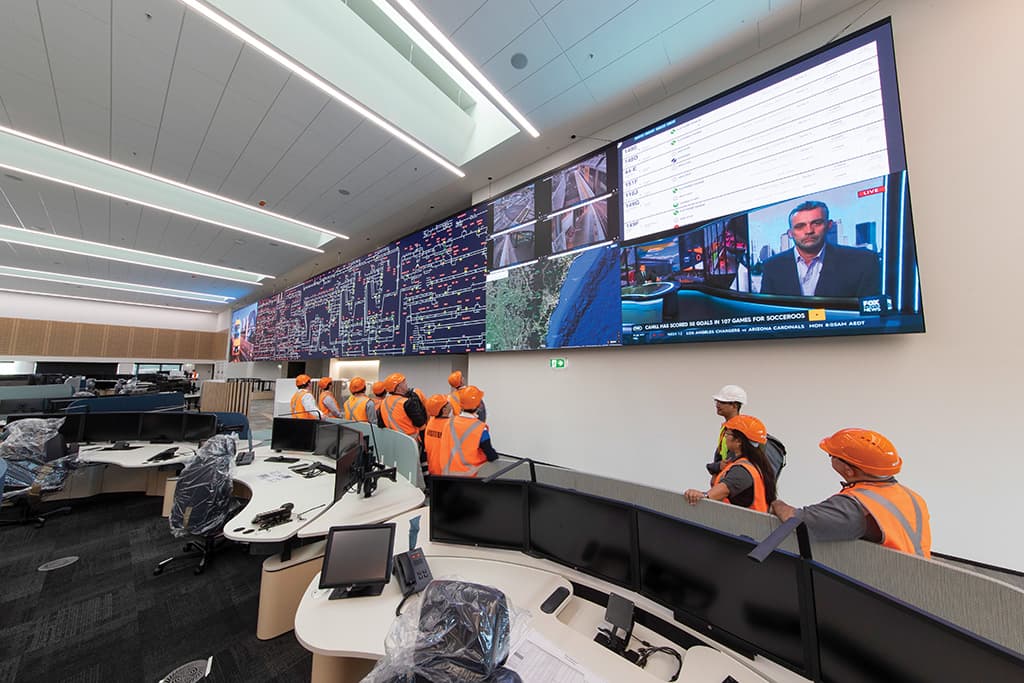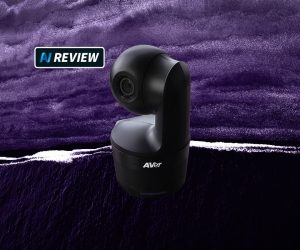Tracking Nicely
It may not be the largest LED wall in the country, but it has more pixels than any other LED display in Australia… possibly the world.
Text:/ Derek Powell
Literally standing tall inside Sydney Trains new Rail Operations Centre (the ‘ROC’ for short) is a massive LED wall that, in terms of resolution, dwarfs any other LED display in the country. It’s ground-breaking too, as it is one of the first command and control displays realised using LEDs instead of the more common rear projection cubes or LCD monitor walls. Astonishingly, with 41 million active pixels, the LED solution was chosen in part, because it had less resolution than some of the competing technologies.
The videowall was designed and installed by Critical Room Solutions as part of a project that consolidated a number of Sydney Trains operational groups into a purpose built facility in the inner Sydney suburb of Alexandria.
Technically, the 32.5m long, 3.6m high wall is known as an Operational Visual Display System or OVDS for short. But OVDS is a bit of a mouthful, so it is more often referred to as the ‘Wow board’. It’s an appropriate moniker which exactly described the reaction from the more than 400 staff who now work in the ROC, on first seeing the massive display. But as we’ll discover, the nickname actually originated quite early in the three-year project.
SOMETHING SPECIAL
To find out more, AV Asia Pacific spoke to Chief Operations Officer Lena Kimenkowski, and Technical Supervisor John Kimenkowski, the dynamic brother and sister team behind Critical Room Solutions (CRS). They are the second generation of a company that has a 30-year history, specialising in control room design on major infrastructure projects, with offices in Perth and Adelaide. Not surprisingly, given the focus of the company, CRS was invited to provide submissions for the project quite early on.
“Going back two or three years,” Lena recalled, “I was at a conference where [Sydney Trains] spoke about the future of the ROC. Following up, we were involved in quite a few expressions of interest; calls for information about our capability and about what we could do. And then it started getting more serious – about the actual solutions rather than about the company. They were testing that the companies could not just deliver on components but also to help develop the solution, ultimately. The nice thing about the project was that, from the beginning, the client said that it should be a Wow wall. That gave us the freedom to put forward something that was really interesting.”


HERE’S THE PITCH
One of the more interesting factors in the design was the decision to pitch an LED solution rather than the more traditional command and control solution of rear projection cubes. John Kimenkowski explained that CRS’s decision to recommend a NanoLumens LED wall wasn’t the obvious choice but was driven by good science.
“The tender actually called for cubes,” John noted. “That’s what they had in some of their existing locations and while we could do a cube wall that size, we realised that [with so many cubes] the overall resolution would be far more than was needed. The key driver was getting big clear images and if you scale sources at a lower resolution to that size it starts to lose quality. So what we really aimed for was to get a pixel perfect image that was simply a lot bigger. And the only way to achieve that is with LED technology.
“As soon as we saw floor plans of the room and how big they wanted this wall to be, our first thought was: this is a prime opportunity [for the kind of technology] that we think will be the future of all control room displays. And that is LED technology. When you start looking at its lifetime; how easy it is to service; how little power it uses when run at lower brightness. We obviously don’t need to run anywhere near the potential brightness – we’re currently actually running at about 36 percent – and it’s still just so vibrant and bright.”
PROOF OF CONCEPT
Knowing that the LED wall was a non-compliant proposal, with the support of its major vendors, CRS proposed a proof of concept demonstration. “We took a whole bunch of equipment – and one twentieth of the entire display – out to one of their sites and set it all up,” John explained. “We were giving our idea of what an ideal control room control environment looks like. Lots of stakeholders came through and had the opportunity to ask questions. So it was a very hands-on experience rather than keeping everything in that sort of tender format where bits of information can very easily get misunderstood or lost.”
Once a technology decision was made and contracts awarded, the detailed design evolved rapidly. The final layout, as defined by Sydney Train’s ergonomists and technical operations team, called for one main display – the Operational Visual Display Screen (the OVDS or ‘Wow Board’) to provide critical information to all the operational groups.
GEAR HIGHLIGHTS
- 1 × NanoLumens Custom 1.6mm LED display, made up of 500 cabinets, 20x send cards, 1000 receive cards, 6000 nixel boards and approx 1500 cables.
- 54 × Panasonic TH55VF1H Ultra narrow bezel 55-inch video wall displays
- 54 × Infinigrid videowall mounting brackets
- 5 × VuWall, VuScape 640 video wall processors in various configurations
- 82 × Techlogix fibre DVI extenders
- 5 × Techlogix 12 port low voltage power supplies
- 10 × Extron TLP1025T touch panels
- 4 × Extron IPCP 350 control processors
- 1 × Extron IPCP 555 control processor
- 2 × Extron DMP 128 Plus
- 8 × Extron CS3T ceiling speakers
- 10 × Extron SW4 HD 4K plus HDMI switchers
- 3 × Shure MXA 910 ceiling microphones
- 3 × Panasonic AW-HE38H VC cameras
- 2 × Panasonic toughpads and docking stations
- 4 × Crestron Airmedia AM-101
- 2 × SMART technologies 7075 75-inch SMART board
- 1 × SMART technologies 7086 86-inch SMART board
- 1 × IHSE Draco Enterprise KVM matrix chassis
- 1 × IHSE Draco Compact KVM matrix
- 16 × IHSE R474 Con boards
- 80 × IHSE L474 CPU boards
- 16 × IHSE 474-BODY6R power bays for cards

THE NUMBERS
Suspended from the ceiling along the front wall, the stunning 32.5m long x 3.6m high display enables Sydney Trains’ controllers to monitor the entire rail system; control trains, tunnels and platforms; and deliver a safe and reliable journey to its millions of daily customers. The 1.6mm pixel pitch LED display contains 41 million pixels configured as 19,200 x 2160 – equivalent to 20 full HD resolution displays.
The largest display element switched to the display is the graphical map of the entire network created by the Train Location System (TLS). The TLS display usually occupies the centre portion of the wall where it allows the train controllers to see the immediate and knock-on effects of any delays or outages and schedule new services as needed. Other inputs available to the videowall include off-air television via Foxtel or pictures from any of the thousands of CCTV cameras that monitor tracks, platforms and concourses across the network.
WALL MANAGEMENT
Managing the huge display area is a VuWall processor which takes in HDMI feeds from 30 PCs to turn the LED Wall into one giant canvas, allowing any bit of information to be displayed anywhere – making the system very flexible. To make the display quick and intuitive to operate, a number of templates have been devised to meet regular requirements. Within the various areas defined on the templates, individual sources can be changed at will.
An enterprise KVM solution from IHSE allows operators to directly control each source PC, allowing them to call up particular views at will. Ten operator desks are equipped to allow local preview and control of every source relevant to their location so they can work closely with a piece of content before publishing it to the desired wall.
Dedicated Extron control processors with a bespoke graphical user interface, allow for an easy to use interface to the whole solution. CRS’s own ‘Wall Builder’ technology allows Sydney Trains’ operators to interact with the video walls after only 10 minutes of familiarisation and basic training.
POD RACING
In addition to the OVDS, there are three other videowall ‘pods’ on the main floor of the Rail Operations Centre. These provide specialised information display to teams responsible for the Sydney Trains’ own electrical network (the Electrical Operations Centre); the Infrastructure Operations Centre (responsible for bridges, level crossings and more) and the Rail Technology Operations Centre. The three displays are each made up of 12 x Panasonic 55-inch ultra-narrow bezel LCD screens, two walls in a four by three format; and one as a six by two display. Each pod has its own videowall processor; control system; and a Foxtel box to view news coverage of any incidents.
INCIDENT ROOM
But wait, there’s more! On an upper floor, overlooking the control centre are two other high-tech facilities. The Incident Management Room and Executive meeting Room are separated by an operable wall but can be joined together in case of a major incident. Each room has similar technology: smart boards, videoconference equipment, and ceiling array microphones to facilitate communications for routine meetings or critical events. Each room also has its own LCD videowall display that can mimic the OVDS or carry separate information as needed.
CONTROL FREAKS
After a hectic 14-month delivery schedule, CRS have created a stand-out, first of a kind control room solution. Perhaps more importantly, they have also generated a satisfied customer.
“CRS have done an exceptional job delivering the OVDS system into our Sydney Trains flagship Control Room,” commented Ibrahim Fazah, Sydney Trains ROC Program, Facility Technical Manager. “They were able to manage a complex delivery during all the phases of the project from managing our challenging requirements during the design stage, the complex construction of the screen support in our new purpose built facility as well as full system installation, configuration and commissioning.”
Though it won’t be seen by the travelling public, the display represents a massive investment in ensuring the safety of passengers who make more than 1.3 million journeys every day on Sydney’s rail network.
FACTS & FIGURES
Total project value: ~$6.2million AUD
Total project man hours: ~9000hrs
Contract award to Completion: ~14 months
MAIN DISPLAY
Display type: 1.6mm pitch LED
Display Size: 31.5m long × 3.6m high
Resolution: 19,200 × 2160
Pixel Count: 41 million (approx.) 3 LEDs per pixel – over 124 million individual LEDs!
Weight: ~6 tonnes
Power draw: ~160amps
Expected lifetime: 100,000hrs +
Cabling: Over 7km worth of Cat6 STP
PODs Displays x3
Display Type: 55-inch Ultra Narrow Bezel (1.7mm) LCD monitors
Display Sizes: 2× 4×3 4.9m long × 2m high 1× 6×2 7.3 long × 1.3m high
Resolution: 2× 7680×3240, 1× 11,520×2160
Pixel Count: ~25 million each
Weight: ~400kg
Power draw: ~15amps
Expected lifetime: 60,000hrs +
Cabling: Over 2.5km of fibre optics with DVI extenders
IMR Displays x2
Display Type: 55-inch Ultra Narrow Bezel (1.7mm) LCD monitors
Display Sizes: 1× 6.1m long × 1.3m high 1× 4.9m long × 1.3m high
Resolution: 1× 9600 × 2160, 1× 7680 × 2160
Pixel Count: ~20 million each
Weight: ~400kg
Power draw: ~15amps
Expected lifetime: 60,000hrs +
Cabling: Over 400m of fibre optics with DVI extenders
BACKEND
- 5× video wall processors with a total of 96 full HD outputs and 112 full HD and 4K HDMI inputs, processing ~320Gigabit of visual information every second
- Over 75 client PCs delivering graphical content to the video walls All PCs controllable at 10 operator desks via a 160 Port KVM matrix solution
- 10× customised control touch screens for simplified and unified control of all devices
- 5× full 42RU racks of equipment 1 floor below
- Over 1000 individual pieces of equipment, excluding LED wall components
- Over 3000 individual patch and interconnect cables used, all labeled and documented
- Over 135 Project documents produced
- Over 65 pages of system diagrams detailing the interconnections
TEAM DETAILS
Principal:
Critical Room Solutions – Lena Kimenkowski and John Kimenkowski
Project Management & LED Structural Engineering:
Arcadis – Thomas Willets and Chris Slater
LED Support:
NanoLumens – Almir DeCarvalho and Doug Price
Digital Place Solutions – Gerry Thorley and Stephen Rubie
PCB Digital – Chris Day and Phil Giles













RESPONSES